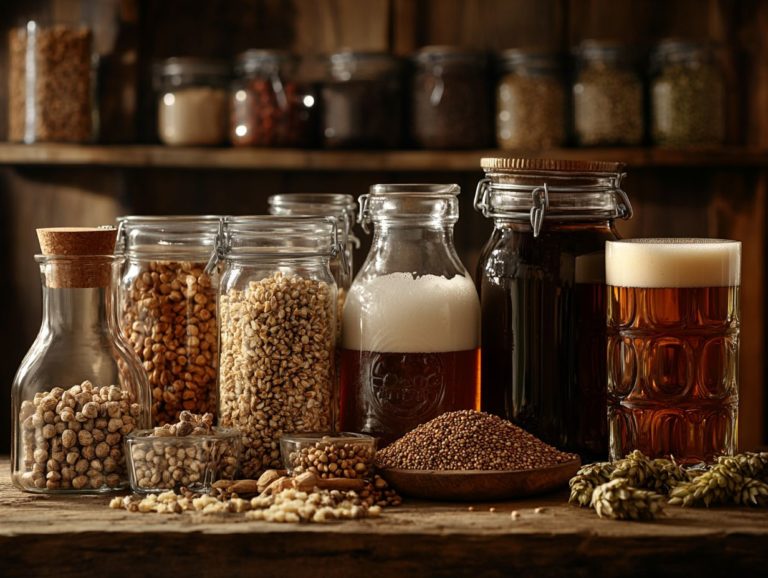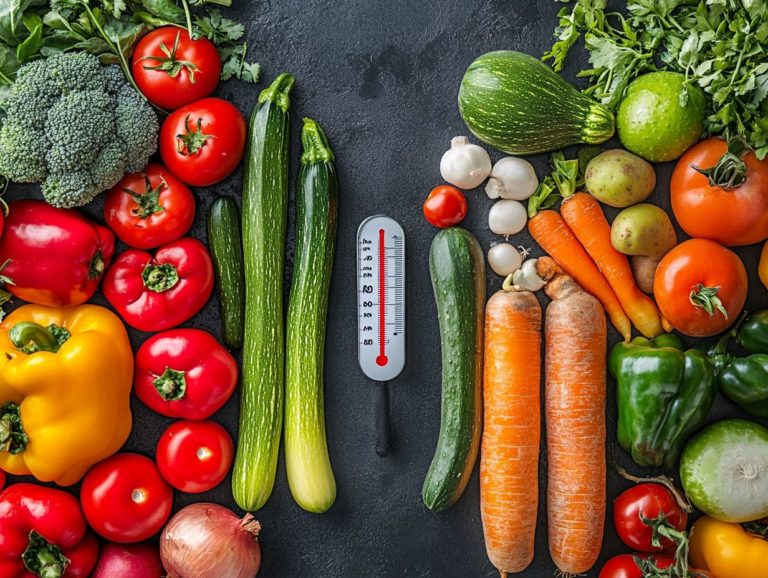A Guide to Brewing with Gluten-Free Ingredients
Contents
- Gluten-Free Brewing: A Comprehensive Guide
- Key Takeaways:
- What Is Gluten-Free Brewing?
- Why Choose Gluten-Free Ingredients for Brewing?
- What Are the Steps for Gluten-Free Brewing?
- Step 6: Add Hops and Other Flavorings
- Step 7: Cool and Transfer to Fermentation Vessel
- Step 8: Ferment and Bottle Your Beer
- What Are Some Tips for Successful Gluten-Free Brewing?
- Frequently Asked Questions
- What are gluten-free ingredients and why use them in brewing?
- What are some common gluten-free ingredients used in brewing?
- Are there any special considerations when brewing with gluten-free ingredients?
- Are there any challenges in brewing with gluten-free ingredients? What role does the immune system play in gluten sensitivity?
- Do gluten-free ingredients affect the taste of the beer? Can gluten-free beer be as flavorful as traditional wheat beer?
- Where can I find gluten-free ingredients for brewing?
Gluten-Free Brewing: A Comprehensive Guide
Crafting beer is truly an art form that captivates many. However, for those with gluten sensitivities and celiac disease, traditional brewing can present quite a challenge.
Fortunately, gluten-free brewing opens up a delightful alternative! It ensures that everyone, including those with gluten intolerance, can indulge in this cherished craft.
This guide delves into the essentials of gluten-free brewing, highlighting the advantages of using gluten-free ingredients. It also provides you with step-by-step instructions and easy recipes for creating unique brews.
Whether you’re a seasoned brewer or just beginning your journey, you ll discover valuable tips and insights designed to elevate your gluten-free brewing experience. This includes advice on crafting gluten-free beverages such as kombucha, mead, and hard cider.
Key Takeaways:
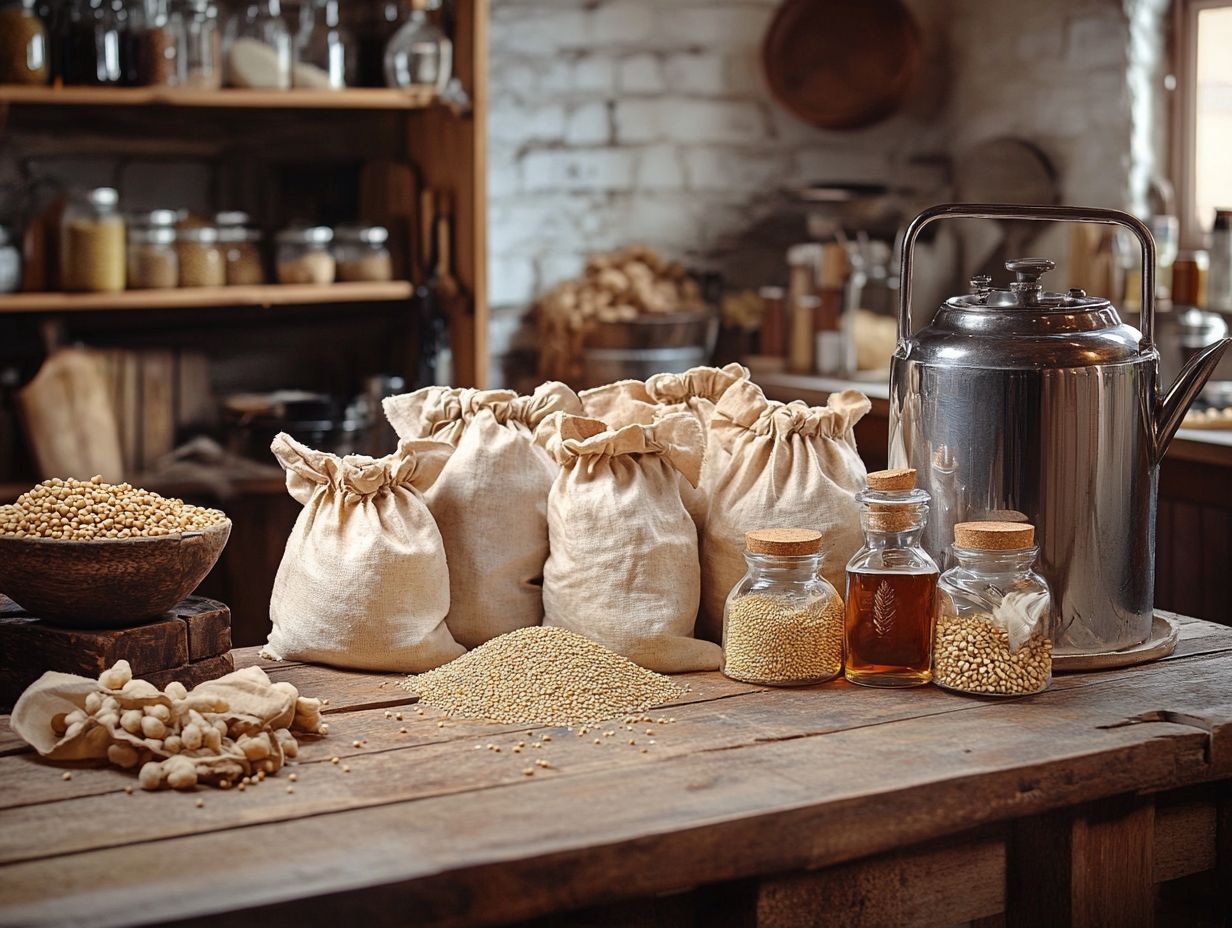
- Gluten-free brewing is a process of making beer without traditional ingredients that contain gluten.
- Choosing gluten-free ingredients for brewing provides options for those with celiac disease or gluten intolerance and can also create unique and flavorful beers.
- To successfully brew with gluten-free ingredients, use high-quality ingredients, monitor mash temperature, be patient with fermentation, and experiment with different grains and flavors. Consider employing Clarity Ferm or other enzymes to reduce gluten content in gluten-reduced beer.
What Is Gluten-Free Brewing?
Gluten-free brewing represents a special method tailored for those with gluten intolerance or celiac disease. This allows them to savor craft beer without the health risks linked to traditional brewing methods that rely on barley malt and wheat.
This crafting method harnesses gluten-free ingredients like rice malt, sorghum malt, millet malt, and buckwheat malt. This ensures that the final products are not only delicious but also completely safe for individuals with gluten-related disorders.
This method often incorporates distinctive brewing techniques and fermentation challenges, such as optimizing yeast nutrients and managing the brewing system. This further distinguishes it from conventional brewing practices.
Why Choose Gluten-Free Ingredients for Brewing?
Selecting gluten-free ingredients for brewing is crucial if you have gluten sensitivity, gluten intolerance, or celiac disease. These conditions can pose serious health risks upon gluten consumption.
By embracing gluten-free brewing, you create a safe and enjoyable beer experience for everyone, including those with food allergies. This choice opens the door to a wonderful array of alternative malts to experiment with, such as rice, sorghum, millet, and buckwheat. This allows your creativity to flow while prioritizing safety. Consult with a food allergist to ensure the ingredients meet health requirements.
What Are Common Gluten-Free Brewing Ingredients?
Common gluten-free brewing ingredients encompass a range of alternative malts, including rice malt, sorghum malt, millet malt, and buckwheat malt. These elegantly substitute traditional barley malt in gluten-free beer recipes. These ingredients guarantee the absence of gluten while introducing unique flavor profiles and brewing characteristics that elevate your overall beer experience.
In addition, hops and yeast nutrients are seamlessly integrated to support the brewing process and fermentation. Always ensure the ingredients are clearly labeled as gluten-free to avoid any risk of contamination.
For example, rice malt delivers a crisp and clean flavor, making it an excellent choice for light lagers and refreshing ales. In contrast, sorghum malt imparts a subtly sweet and earthy note, perfect for crafting rich ambers or robust stouts. Millet malt contributes a delightful nutty complexity, beautifully complementing spiced or seasonal brews, while buckwheat malt offers a distinctive, slightly bitter profile that enhances the depth of flavor in your creations.
Utilizing these ingredients can help prevent symptoms associated with gluten sensitivity and leaky gut syndrome. By mastering the balance of these gluten-free ingredients, you have the opportunity to experiment with various techniques such as decoction and infusion mashing. This allows for a broader exploration of unique brews that cater to gluten-sensitive beer enthusiasts.
What Are the Steps for Gluten-Free Brewing?
Ready to embark on a gluten-free brewing adventure? Let s dive into the exciting world of crafting delicious gluten-free beers! The steps for gluten-free brewing closely mirror those of traditional brewing, but they demand meticulous attention to the selection of gluten-free ingredients and the employment of specific brewing techniques. This diligence is essential to avoid contamination and guarantee a successful fermentation.
Your brewing journey starts with selecting a suitable beer recipe that features gluten-free ingredients. From there, you ll prepare the brewing kettle and equipment, mill the grains, mash, sparge (which means rinsing the grains to extract sugars), and boil. Then you’ll progress to the crucial fermentation stage. Use Clarity Ferm by White Labs during this stage for gluten-reduced beer options.
Step 1: Choose Your Base Ingredients
Choosing the right base ingredients is vital for your gluten-free brewing success. These ingredients lay the groundwork for your beer recipe and greatly influence its flavor profile and overall brewing process.
Options like rice malt, sorghum malt, millet malt, and buckwheat malt each offer unique characteristics that can elevate your final product while ensuring it s safe for those with gluten intolerance or celiac disease.
Rice Malt
Rice malt delivers a clean, light flavor that works beautifully for lighter beer styles.
Sorghum Malt
Sorghum malt infuses a fruity and earthy note, enhancing the complexity of ales.
Millet Malt
Millet malt brings a slightly nutty flavor to the table, contributing body to your beer.
Buckwheat Malt
Buckwheat malt offers a robust taste that pairs well with darker and richer styles.
By selecting high-quality gluten-free base ingredients, you open the door to a more flavorful and enjoyable beer experience. The right combination can cater to diverse palates without compromising safety. Ensure every sip is a pleasure. The Cleveland Clinic recommends those with gluten intolerance or celiac disease to strictly adhere to gluten-free ingredients to avoid immune system reactions.
Step 2: Prepare Your Equipment
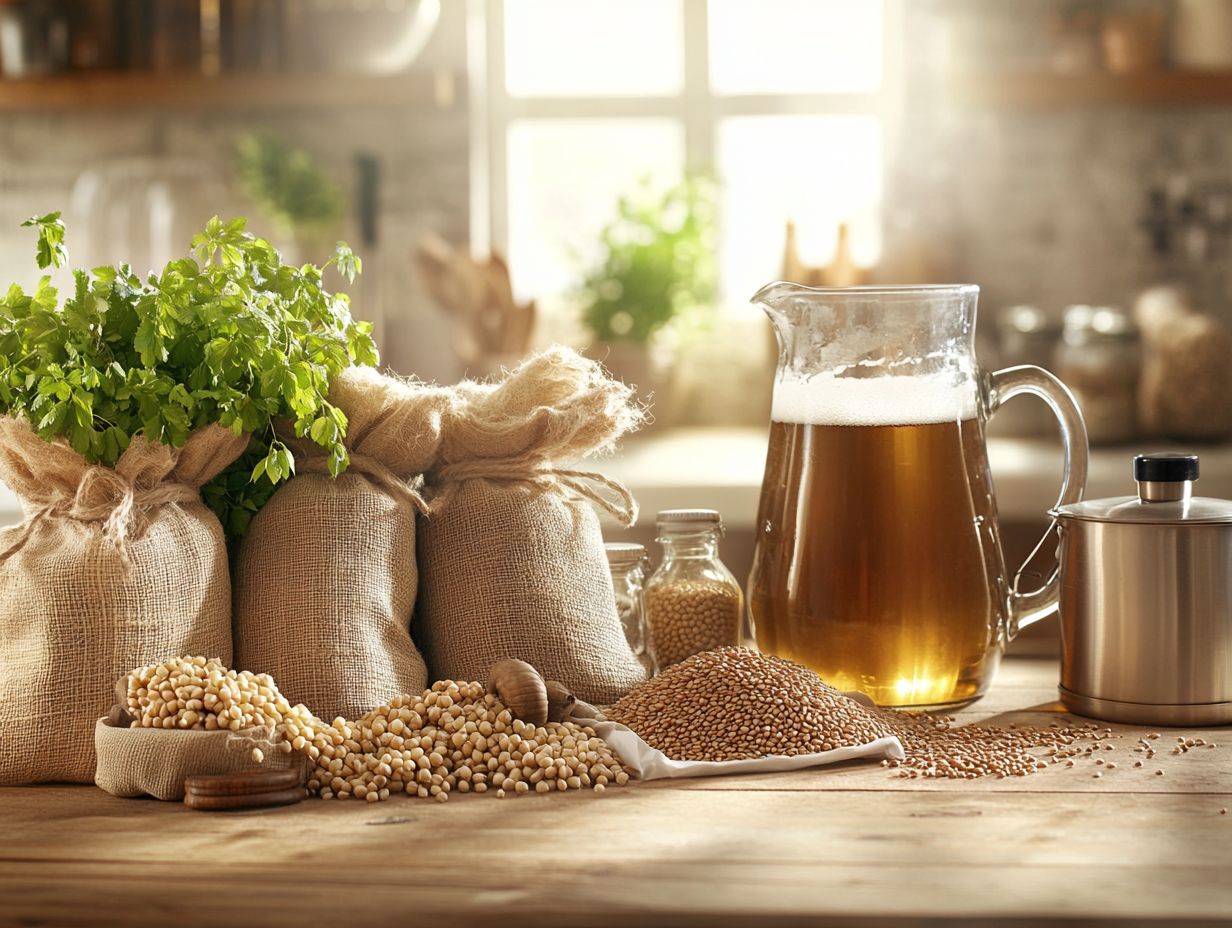
Preparing your brewing equipment is an essential step in the gluten-free homebrewing process. Proper sanitation and setup will help prevent contamination and ensure a successful fermentation of your gluten-free beer.
This preparation involves thoroughly cleaning and sanitizing your brewing kettle, fermentation vessel, and all tools you ll use throughout the brewing process. These steps help prevent gluten contamination, making the beer safe for those with gluten sensitivity or celiac disease.
To start, meticulously clean your brewing kettle. Ensure that any residue from previous batches or other substances is completely removed. This is where the greatness of your gluten-free creation truly begins. Any leftover yeast or bacteria can spoil both the flavor and the fermentation. Symptoms include gastrointestinal distress and other adverse reactions if contamination occurs.
Next, using a no-rinse sanitizer on all your tools like spoons and hydrometers is vital to eliminate any lingering contaminants. Each item you use plays a specific role: the kettle is where you ll boil your gluten-free grains, while the fermentation vessel is critical for yeast activity.
By investing your time and care in this preparation phase, you re setting the stage for a flavorful and successful brew.
Step 3: Mill Your Grains
Milling your grains is a pivotal step in the gluten-free brewing process, allowing you to transform the grains into a coarse powder that maximizes the surface area for optimal extraction of sugars and flavors during mashing. This process is particularly vital for gluten-free ingredients, as it enables you to fully harness the unique characteristics of alternative malts like rice, sorghum, millet, and buckwheat in your beer recipes.
Your choice of milling technique will significantly influence the brewing outcome; the right grind can be the key to a successful brew or a lackluster one. You ll typically want to use a grain mill, which can be adjusted to achieve your desired consistency be it coarse or fine. Aim for a texture that resembles coarse flour or cracked grain to ensure maximum efficiency during the mashing phase. Also, be aware that gluten-free milling often requires more attention to detail due to the varied properties of alternative malts.
For the best results, mill your grains just before brewing, and don t hesitate to experiment with different grain combinations. Each grain may require specific milling adjustments to elevate flavor profiles and enhance overall fermentation efficiency. This will help avoid a full-scale attack on the immune system for those with severe gluten intolerance.
Step 4: Mash Your Grains
Mashing your grains is a vital step in gluten-free brewing that activates the enzymes responsible for converting starches into fermentable sugars, setting the stage for a successful fermentation process. This phase demands precise temperature control to ensure optimal enzyme activity, allowing gluten-free ingredients like rice malt, sorghum malt, millet malt, and buckwheat malt to contribute their unique flavors and sugars to the wort.
During the mashing process, you’ll want to focus on specific temperature ranges; typically, maintaining a temperature around 150-155 F (65-68 C) for about 60 minutes is ideal to maximize enzyme efficiency. The alpha-amylase enzyme thrives at higher temperatures, effectively breaking down long-chain starches, while beta-amylase operates at lower temperatures, producing the essential fermentable sugars.
Enzymatic action plays a crucial role in working with gluten-free grains, as their starch structures differ from those of traditional malts. This may require longer mash times or multiple temperature steps to achieve conversion rates that are comparable. It s important to pay close attention to the distinct characteristics of each gluten-free grain, as their composition not only influences mashing dynamics but also shapes the overall flavor profile of the final brew. Clarity Ferm can be used to further ensure gluten-reduced beer options for those seeking less than 20 ppm gluten content.
Step 5: Sparge and Boil
Sparging and boiling are pivotal stages in your gluten-free brewing adventure, crucial for extracting the last drops of sweetness from your grains while concurrently sterilizing the wort and elevating its flavor profile with hops, similar to a brewing process seen in traditional wheat beer.
During sparging, you ll use hot water to rinse the grains, ensuring you maximize the extraction of fermentable sugars from gluten-free ingredients like rice and sorghum.
This technique not only optimizes your yield but also plays an essential role in achieving the clarity of your final product, addressing gluten intolerance and sensitivity. Once you ve completed sparging, it s time to bring the wort to a vigorous boil, a process with several important functions.
Boiling not only eliminates unwanted bacteria but also provides the perfect opportunity to introduce hops. These hops are key players in your brew, imparting bitterness, aroma, and flavor that beautifully complement the unique characteristics of your gluten-free ingredients.
The interaction between the hops and the sugars extracted from the gluten-free grains creates a complex taste that can closely resemble traditional beers. By understanding and mastering this boiling phase, you ensure a rich and enjoyable drinking experience, proving that gluten-free beers can be just as flavorful as their conventional counterparts, including gluten reduced beer.
Step 6: Add Hops and Other Flavorings
Incorporating hops and other flavorings is essential to the gluten-free brewing process. These elements significantly influence the aroma, bitterness, and overall flavor profile of your beer recipe.
The timing of hop additions during the boiling stage can profoundly impact the characteristics of your gluten-free creation. This offers you the opportunity to experiment with different hop varieties for a truly unique taste experience!
Take classic varieties like Cascade and Citra, which bring vibrant citrus and floral notes to the table. You can also explore more adventurous options like Mosaic, known for its tropical fruit flavors. To elevate your brew, consider adding different flavorings such as coriander or orange peel. Experiment with alternative malts for unique profiles.
Early hop additions, usually made at the start of the boil, lend more bitterness. Late hops introduced in the last 15 minutes enhance aroma without significantly increasing bitterness.
Don t overlook dry hopping during fermentation! This technique can provide a burst of intense hop aroma. Understanding when to introduce each ingredient is crucial for achieving your desired outcome. Mastering these dynamics enables you to craft gluten-free beers that cater to gluten-intolerant consumers, including those with celiac disease and gluten sensitivity, while captivating craft beer enthusiasts with bold and varied flavors.
Step 7: Cool and Transfer to Fermentation Vessel
Cooling the wort and transferring it to the fermentation vessel is a critical step in your gluten-free brewing journey. This process not only prepares the liquid for fermentation but also safeguards it against bacteria and other unwanted microbes.
Once you’ve cooled the wort to the optimal temperature, adding yeast nutrient is key to promoting healthy yeast activity. This ensures a successful fermentation for your gluten-free beer.
Using effective cooling methods, such as an immersion wort chiller or a counterflow chiller, can significantly reduce the wort temperature in no time. This minimizes the risk of contamination. It’s essential to maintain precise temperature control during this phase since yeast thrives within specific ranges, allowing it to convert sugars into alcohol efficiently.
After chilling, as you transfer the wort to the fermentation vessel, introducing yeast nutrient becomes paramount. This nutrient provides the essential elements for yeast to perform at its best, particularly in gluten-free brewing, where the nutrient profile may differ from that of traditional grains.
Step 8: Ferment and Bottle Your Beer
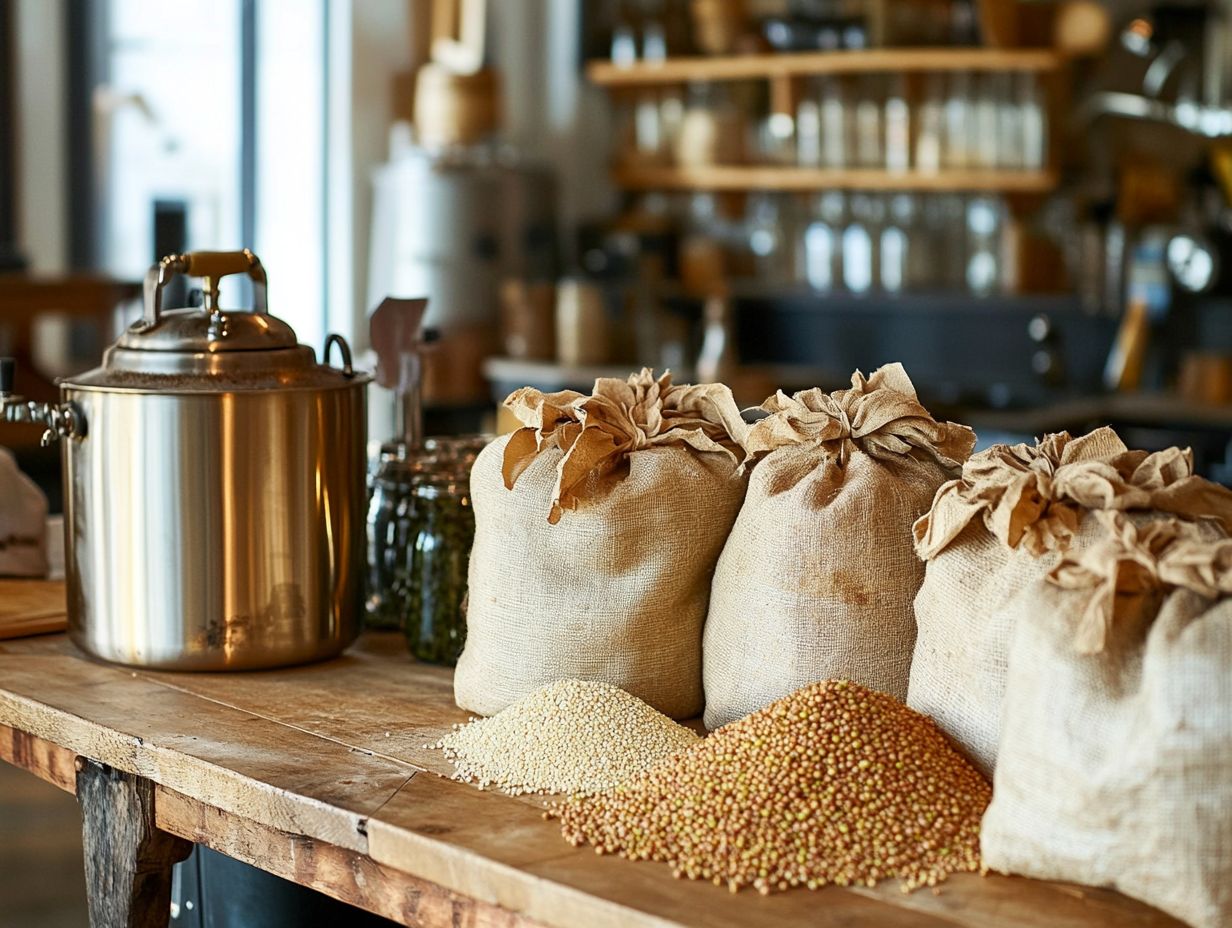
The fermentation and bottling stages mark the grand finale of your gluten-free brewing journey! Here, yeast works its magic, converting sugars from gluten-free ingredients into alcohol and carbon dioxide. This process ultimately shapes the flavor profile and alcohol content of your gluten-free beer.
Once fermentation wraps up, carefully transfer your brew into bottles while prioritizing sanitation. This step allows carbonation to develop, resulting in a refreshing gluten-free beer that s ready for your enjoyment!
Typically, this fermentation process spans about one to two weeks, influenced by the specific yeast strain and the fermentation temperature, which should ideally hover between 65 and 75 degrees Fahrenheit for most gluten-free beers. It s vital to maintain a stable environment; any fluctuations can disrupt fermentation yield and flavor, leaving you with less than desirable results.
After fermentation is complete, don t forget the importance of sanitizing all your equipment to prevent any unwanted contamination during bottling. Using techniques like siphoning to transfer your beer minimizes oxygen exposure, helping to preserve those delicate flavors. A commitment to cleanliness during these stages not only enhances the safety of your brew but also elevates the overall quality of your final product. Utilizing yeast nutrient and clarity ferm, a product that helps improve the clarity of the beer, can aid in improving fermentation quality and final beer clarity!
What Are Some Tips for Successful Gluten-Free Brewing?
Achieving success in gluten-free brewing requires your careful attention to detail and a solid understanding of brewing techniques. It’s also important to recognize the unique challenges presented by gluten-free ingredients. Consulting with a food allergist can provide insights on managing food allergies and gluten sensitivity while brewing.
By employing effective strategies and adhering to best practices, you’ll master fermentation hurdles and craft exceptional gluten-free beer that appeals to a diverse audience, including those with gluten intolerance or celiac disease.
Tip 1: Use High-Quality Gluten-Free Ingredients
Using high-quality gluten-free ingredients is essential, as the quality of these components directly influences the flavor profile, aroma, and overall enjoyment of your gluten-free beer. Source premium rice malt, sorghum malt, millet malt, and buckwheat malt to achieve the best taste and texture. Consider the Clarity Ferm enzyme by White Labs to improve clarity and reduce gluten content in your brew.
The selection of these ingredients affects not only the boldness of flavors but also impacts mouthfeel and carbonation levels. When brewing your gluten-free beer, seek suppliers who emphasize freshness and organic practices. Take time to research and read reviews about various brands, and join local grains festivals or co-ops where fellow enthusiasts share invaluable sourcing tips. Incorporating alternative grains like millet, sorghum, rice, and buckwheat can diversify your brew.
Investing effort into finding top-notch ingredients will elevate your final product, transforming each sip into a delightful exploration of flavors.
Tip 2: Monitor Your Mash Temperature
Monitoring your mash temperature is vital in gluten-free brewing, as it directly influences how enzymes work to convert starches into sugars during the mashing process. By maintaining optimal mash temperatures, you promote effective enzyme action, ensuring your gluten-free ingredients yield maximum fermentable sugars for your beer recipe, just as in traditional brewing systems.
Different mash temperatures lead to varied outcomes, impacting the flavor, body, and mouthfeel of your final product. For instance, a lower mash temperature typically produces more fermentable sugars, resulting in a lighter-bodied beer, while higher temperatures enhance unfermentable sugars, contributing to a fuller mouthfeel.
To achieve and sustain ideal mash temperatures, use a thermometer with precise calibration and ensure consistent heat distribution throughout your mash tun. Regularly check the temperature during mashing to prevent fluctuations that might jeopardize enzyme activity and, consequently, the quality of the beer you produce.
Start sourcing your ingredients from local co-ops today for the best results in your gluten-free brewing journey!
Tip 3: Be Patient With Fermentation
Patience is your best ally in gluten-free brewing. Give the yeast ample time to convert sugars into alcohol to achieve balanced flavors. Rushing this process can lead to off-flavors that diminish the overall quality of your gluten-free beer. This patience becomes even more vital when you consider the unique fermentation challenges that can arise from using alternative malts and managing gluten intolerances.
The fermentation timeline varies. Factors like temperature, yeast strain, and gluten-free grains affect it. As a home brewer, you should make it a habit to monitor the sugar level in your brew with a hydrometer. This essential tool helps you track how much sugar has been converted into alcohol. Keep an eye out for visual cues like bubbling in the airlock and sediment formation, which indicate yeast activity. Addressing fermentation challenges promptly can ensure better outcomes.
Resist the temptation to rush. Only proceed to bottling or kegging once fermentation seems complete, which is typically signaled by a consistent gravity reading over several days. Ultimately, trusting your yeast and allowing them to work at their own pace will lead you to a superior final product.
Tip 4: Experiment with Different Gluten-Free Grains and Flavors
Explore various gluten-free grains like millet, sorghum, rice, and buckwheat. Each adds unique flavors and textures to your gluten-free beer. Consider unconventional brewing ingredients like kombucha, mead, and hard cider for innovative tastes.
By experimenting with different grains, you uncover exciting possibilities. Craft unique gluten-free beers that cater to various tastes. Incorporating a range of gluten-free ingredients like millet, buckwheat malt, and sorghum malt enables you to develop innovative beer recipes that showcase the distinct characteristics of each grain.
These grains introduce diverse taste profiles. Incorporating hops, enzymes, and yeast nutrients can enhance the flavors of your creations. For example, blending fruity sorghum malt with hints of citrus zest can yield a refreshing summertime brew, while roasted buckwheat adds a nutty, rich complexity to darker ales.
Engaging with different grains encourages you to refine your brewing techniques. Utilizing a brewing kettle and a well-calibrated brewing system can significantly improve the brewing process. This exploratory approach not only makes brewing more enjoyable but also elevates the tasting experience, allowing you to appreciate the subtleties of gluten-free options within the craft beer landscape.
Frequently Asked Questions
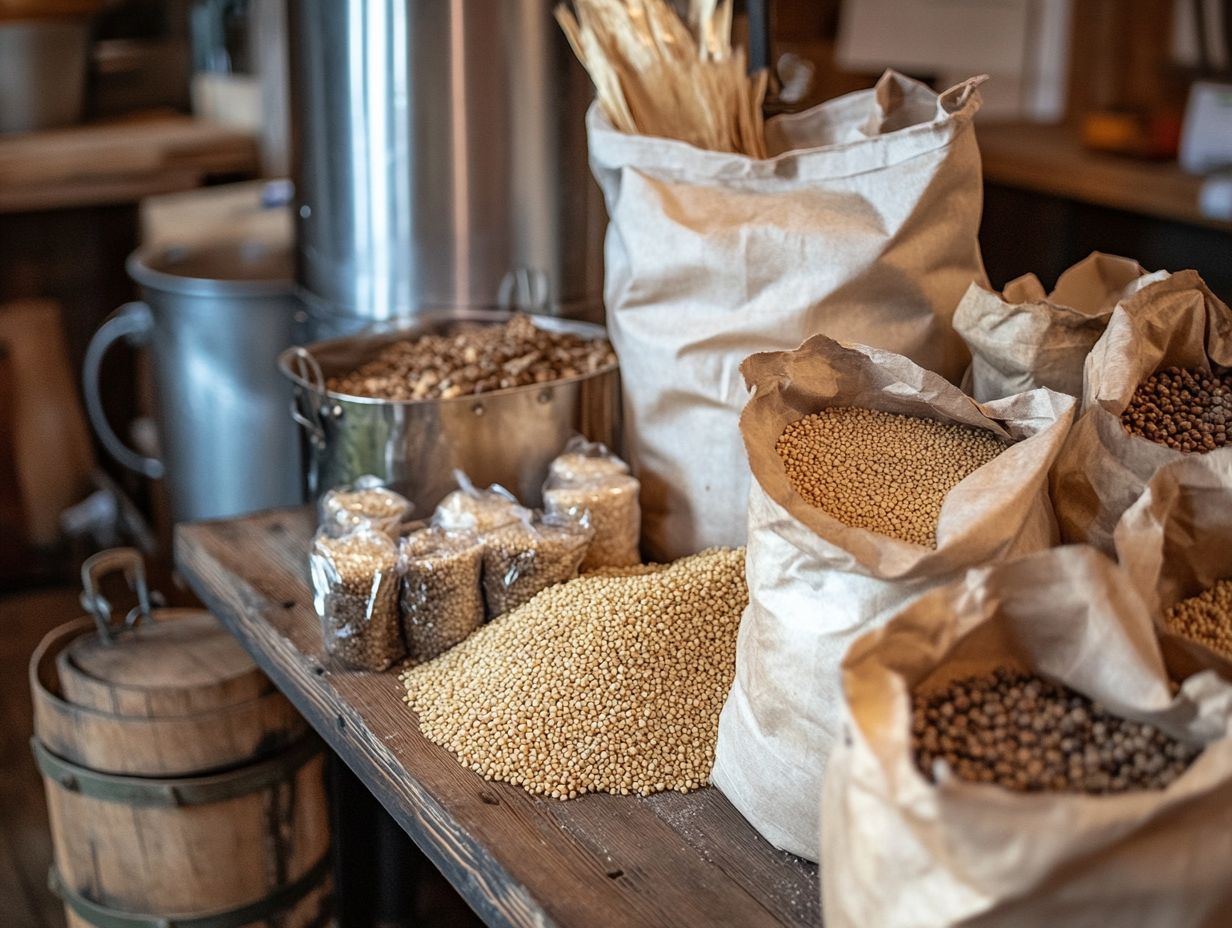
What are gluten-free ingredients and why use them in brewing?
Gluten-free ingredients are those that do not contain gluten, a protein found in grains such as wheat, barley, and rye. Many people choose to use these ingredients in brewing to cater to those with gluten intolerance, gluten sensitivity, or celiac disease. Symptoms include digestive issues and can lead to more severe conditions like leaky gut syndrome.
What are some common gluten-free ingredients used in brewing?
Common gluten-free ingredients used in brewing include sorghum, rice, buckwheat, millet, and quinoa. These provide fermentable sugars and can replace traditional grains like barley malt and wheat. Incorporating these ingredients can create delicious and easy recipes for gluten-free homebrewing.
Are there any special considerations when brewing with gluten-free ingredients?
Yes, there are a few things to keep in mind when using gluten-free ingredients in brewing. These ingredients may require longer mashing times and different enzymes. They may also need higher amounts of additional ingredients to achieve the desired flavors and body.
Utilizing products like Clarity Ferm from White Labs can help reduce gluten content, creating gluten-reduced beer options.
Are there any challenges in brewing with gluten-free ingredients? What role does the immune system play in gluten sensitivity?
Yes, brewing with gluten-free ingredients can pose some challenges. These ingredients may not have the same amount of fermentable sugars as traditional grains, which can result in lower alcohol content. They may also affect the overall flavor and mouthfeel of the beer.
Consulting with a food allergist or healthcare professional can help manage any food allergies related to gluten-free homebrewing.
Do gluten-free ingredients affect the taste of the beer? Can gluten-free beer be as flavorful as traditional wheat beer?
Yes, gluten-free ingredients can impact the flavor of the beer. Depending on the type and amount of ingredients used, the beer may taste different from traditional beer. However, many brewers have found ways to create delicious gluten-free beer that is comparable in taste to traditional beer.
Combining these ingredients with innovative brewing techniques can produce a variety of craft beer options.
Where can I find gluten-free ingredients for brewing?
Gluten-free ingredients can be found at specialty homebrewing stores or online. It’s important to ensure that the ingredients are certified gluten-free to make sure they are safe for those with gluten intolerance or celiac disease.
Products like Clarity Ferm are designed to reduce gluten levels, making the brewing process more accessible for those with gluten sensitivity.

